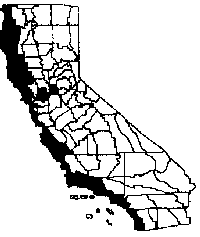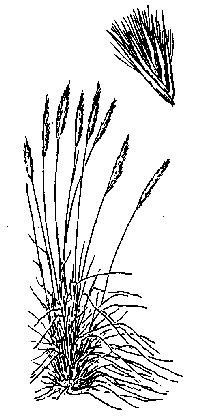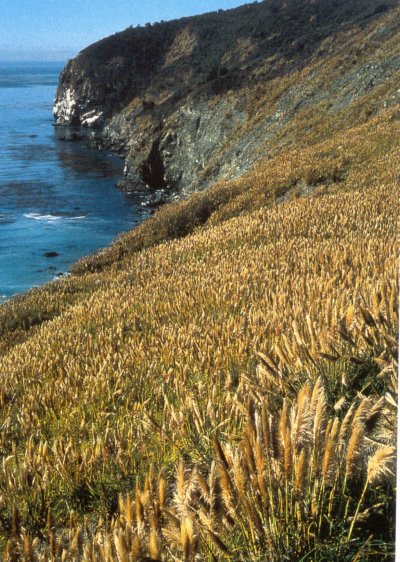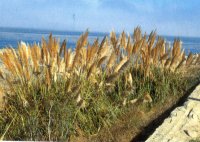|
Cortaderia jubata
|
|
|
|
Scientific name
|
Cortaderia jubata
|
|
Additional name information:
|
(Lemoine) Stapf
|
|
Common name
|
jubata grass, pampas grass, Andes grass, selloa pampas grass, cortaderia, pink pampas grass, purple pampas grass
|
|
Synonymous scientific names
|
Cortaderia atacamensis
|
|
Closely related California natives
|
0
|
|
Closely related California non-natives:
|
Cortaderia selloana
|
|
Listed
|
CalEPPC List A-1,CDFA nl
|
|
By:
|
Joseph M. DiTomaso
|
|
Distribution
|
|
|
HOW DO I RECOGNIZE IT?
Distinctive features:
|
Jubata grass (Cortadaria jubata)
is a perennial grass six to twenty-three feet tall with long leaves arising from
a tufted base or tussock. The inflorescence or flower cluster is a plumed
panicle at the end of a long stem. Stems generally are at least twice as long as
the tussock. Plumes consist of hairy female flowers, deep violet when immature,
turning pinkish or tawny cream-white at maturity. Jubata grass is easily
confused with, and often called, pampas grass (Cortaderia selloana).
The two species are distinguished by stem height, leaf, plume, and spikelet
color, florets, leaf tip, and presence of viable seed. The tussocks of jubata
grass are less erect and more spreading and not fountain-like, when compared to
tussocks of Cortaderia selloana.
| Characteristic |
Cortaderia jubata |
Cortaderia selloana |
| Stem (culm) height
|
2-2.5 times longer than
tussock
|
equal to or slightly longer than
tussock in female plants; two timesåÊlonger in male
plants
|
| Leaf color |
bright to deep green
|
glaucous-green |
| Plume color |
pinkish to deep violet
|
ight violet to silvery white;
femaleåÊplants with lighter plumes thanåÊmales
|
| Spikelet color |
glumes purple |
glumes white; males
sometimesåÊpurplish near base
|
| Florets |
hairy at base; awn slightly extending beyond hairs
|
males sparsely or not
at all hairy;åÊfemales densely hairy at base,
awnsåÊtwice the length of hairs
|
| Leaf tip |
not bristly or curled
|
bristly and curled |
| Viable seed |
yes |
only when male and female plants are
present
|
åÊ
|
|
Description:
|
| Poaceae. Perennial grass. Leaves: blades 3-5 ft (1-1.5 m) long, 0.8-4 in (2-10 cm) wide, flat or slightly V-shaped in cross-section, deep green, upper and lower surfaces glabrous, occasionally with hairs near collar on upper surface, tips not setaceous (bristly) or curled, margins scabrous and sharp. Sheath: densely hairy. Inflorescence: dense panicle, 1-3 ft (3-10 dm) long, flexuous, deep violet when immature, pinkish turning cream-white or tawny at maturity. Spikelets: numerous, all female, 0.6 in (14-16 mm) long, 3-5 florets in each. Florets: 0.12-0.2 in (3-5 mm) long, glumes purple, lemma long-hairy, awns short |
|
|
|
WHERE WOULD I FIND IT?
|
In California jubata grass occurs only in
coastal areas (DiTomaso et al. 1999). It has become common in disturbed ditch
banks, road cuts, cliffs, and cut-over areas, and eroded or exposed soil below
2,600 feet (800 m) elevation in the coastal fog belt from Santa Barbara County
to Humboldt County, and less frequently in open habitats of southern California
(Costas-Lippman 1977). Large infestations are common along US Highway 1 near Big
Sur. Jubata grass nearly always occurs on open sites, such as roadside cuts,
forest clearcuts, mudslides, or burned areas. Although typically found on sandy
soils, jubata grass can survive on other soil types, including
serpentine.
åÊ
|
|
WHERE DID IT COME FROM AND HOW IS IT SPREAD?
|
Jubata grass is native to northern Argentina and the Andes of
Bolivia, Peru, Chile, and Ecuador (Costas-Lippmann 1977). In its native range it
can be found from sea level to elevations greater than 11,000 feet (3,400 m). It
was first cultivated in France and Ireland from seed collected in Ecuador
(Costas-Lippmann 1977). It is not clear how or when it was introduced into
California, but it may have come through France via the horticultural trade
(Madison 1992).
Jubata grass was first reported as a weed in California in
logged redwood forests of Humboldt County in 1966 (Fuller 1976). Since
infestations exist only in coastal areas of California, it is likely that the
origin of this weed is a low-elevation biotype from South America. Because all
seed production occurs without pollen transfer (apomictic), little genetic
diversity exists within these plants (Connor 1973). This would explain its
limited range in California. Spread occurs by wind-blown seed or by humans using
mature inflorescences in decorative arrangements or using plants in landscaping.
Seeds have been reported to disperse over twenty miles under windy conditions
(Gadgil et al. 1984). Movement throughout the state also occurs when nurseries
mistakenly sell this weedy species instead of Cortaderia selloana (Madison
1992).
åÊ
åÊ
|
|
WHAT PROBLEMS DOES IT CAUSE?
|
Large infestations threaten CaliforniaÛªs
native coastal ecosystems by crowding out native plants, particularly in
sensitive coastal dune areas (Cowan 1976). In addition to its effect on native
plant diversity, jubata grass can reduce the aesthetic and recreational value of
natural areas. In cut-over coastal redwood forests in northern California,
jubata grass suppresses reestablishment of seedling conifers (Madison 1992). It
is a significant weed problem in forestry operations and conservation areas in
other countries, particularly New Zealand and Australia (Gadgil et al. 1984,
Harradine 1991). In forests, jubata grass can outcompete seedling trees and
retard their establishment and growth. It creates a fire hazard with excessive
build-up of dry leaves, leaf bases, and flowering stalks. Large clumps can
complicate fire management activities by blocking vehicle and human access and
by becoming fire hazards themselves. The sawtoothed leaves can cause injury to
humans.
åÊ
|
|
HOW DOES IT GROW AND REPRODUCE?
|
Reproduction of jubata grass is by asexual means only. Flowers typically are produced from late July to September (Madison 1992), even in the first year of growth. Plants can flower twice during the same season. Although all plants produce only female flowers, viable seeds develop from unfertilized ovules (apomixis). No pollination is necessary. All seedlings are genetically identical to the parent plant. This unusual form of reproduction is probably the most important characteristic responsible for the weediness of jubata grass, as well as its limited range. An individual inflorescence can produce 100,000 minute seeds (Harradine 1991), and large clumps can produce a million or more seeds (Cowan 1976). Like Cortaderia selloana, jubata grass can also reproduce vegetatively from fragmented tillers that produce adventitious roots in moist soils.
|
Germination generally occurs in spring and requires sandy soils, ample moisture, and light. The temperature range for germination is 55 to 70 degrees F (13-21 degrees C), with an optimum temperature of 63 degrees F (17 degrees C) (Drewitz and DiTomaso unpubl. data).
|
(click on photos to view larger image)
|
Seeds do not appear to survive long in the soil, although no
detailed studies have yet been conducted. Seedling growth and establishment are
most rapid on bare, sandy soil and exposed road cuts, but typically require
cool, foggy climate and moist soil (Cowan 1976). Seedling survival is low in
shaded areas or in competition with grasses (Gadgil et al. 1990) or sedges.
Growth initially is slow, but once established, plants grow rapidly. Roots are
clustered in a shallow crown and can be fine to fairly thick. Technically, the
roots are considered fibrous. Jubata grass does not tolerate winter frost
(Costas-Lippman 1977), hot summer temperatures, intense sunlight, or drought.
This may account for its inability to become established in the Central Valley
of California. Plants are capable of surviving about fifteen years (Moore
1994).
åÊ
|
|
HOW CAN I GET RID OF IT?
|
Control of jubata grass is similar to
methods used to remove pampas grass. Because of the sensitivity of coastal sites
occupied by jubata grass, few control strategies are available. Infestations
sometimes can be averted by overseeding disturbed sites with desirable
vegetation to prevent jubata grass seedling establishment.
åÊ
|
|
Physical control:
|
Manual methods: Pulling or hand grubbing
jubata grass seedlings is highly effective. Seedling leaves are shiny, stiff,
and erect. Other more desirable grasses are not as stiff. For larger plants,
however, a pulaski, mattock, or shovel are the safest and most effective tools
for removing established clumps. To prevent resprouting, it is important to
remove the entire crown and top section of the roots. Detached plants left lying
on the soil surface may take root and reestablish under moist soil conditions
(Harradine 1991). A large chainsaw or weedeater can expose the base of the
plant, allow better access for removal of the crown, and make disposal of the
detached plant more manageable (Moore 1994). Cutting and removing or burning the
inflorescence is important to prevent seed dispersal during the operation (Cowan
1976, Harradine 1991). This is best accomplished prior to seed maturation. To
reduce labor, the top of the foliage can be removed and the remaining crown
treated with diesel oil (Cowan 1976).
Prescribed burning: Burning does not provide long-term control.
The growing points of the grass are protected by surrounding leaves. This leads
to rapid resprouting following a burn.
åÊ
|
|
Biological control:
|
Insects and fungi: No insect or fungi
control agents have yet been investigated.
Grazing: Successful control by grazing has not been reported in
the United States, but cattle have been shown to be effective in controlling
jubata grass in commercial forests of New Zealand (Harradine 1991, Gadgil et al.
1984).
åÊ
|
|
Chemical control:
|
Control of jubata grass can be achieved by spot treatment with a
post-emergence application of glyphosate at about 2 percent solution or eight
quarts per 100 gallons. The addition of a non-ionic or silicone-based surfactant
may be necessary to enhance foliar penetration of the herbicide. For most
effective control, plants should be sprayed to wet, but not to the point of
runoff. In one study, over 90 percent control was obtained during the first
season, but continued spot applications were necessary to prevent rapid
reestablishment (Madison 1992). Fall applications result in better control than
do summer applications (Costello 1986) because photosynthetic assimilates are
translocating downward at a faster rate late in the season. However, it may be
necessary to apply the herbicide prior to maturation of viable seed in late
summer. Low-volume (20 gal/ac) treatment with glyphosate at 4 percent can
provide excellent control and reduce the amount of herbicide used as well as the
cost of the treatment (Drewitz et al. unpubl. data).
Other registered post-emergence herbicides may also be effective
in the control of jubata grass. These include the post-emergence graminicide
fluazifop and the broad-spectrum herbicide imazapyr (Harradine 1991). Imazapyr
at 1 percent low volume provides excellent control applied in spring or fall
(Drewitz et al. unpubl. data). In forestry operations, hexazinone is a
soil-residual root-absorbed compound also effective in the control of jubata
grass (Harradine 1991), but only as a pre-emergence treatment. Once plants have
been killed, clumps can be removed mechanically and left to decompose
naturally.
Rope wick applications of glyphosate have also proven effective,
but good coverage is essential (Drewitz et al. unpubl. data).
åÊ
|




